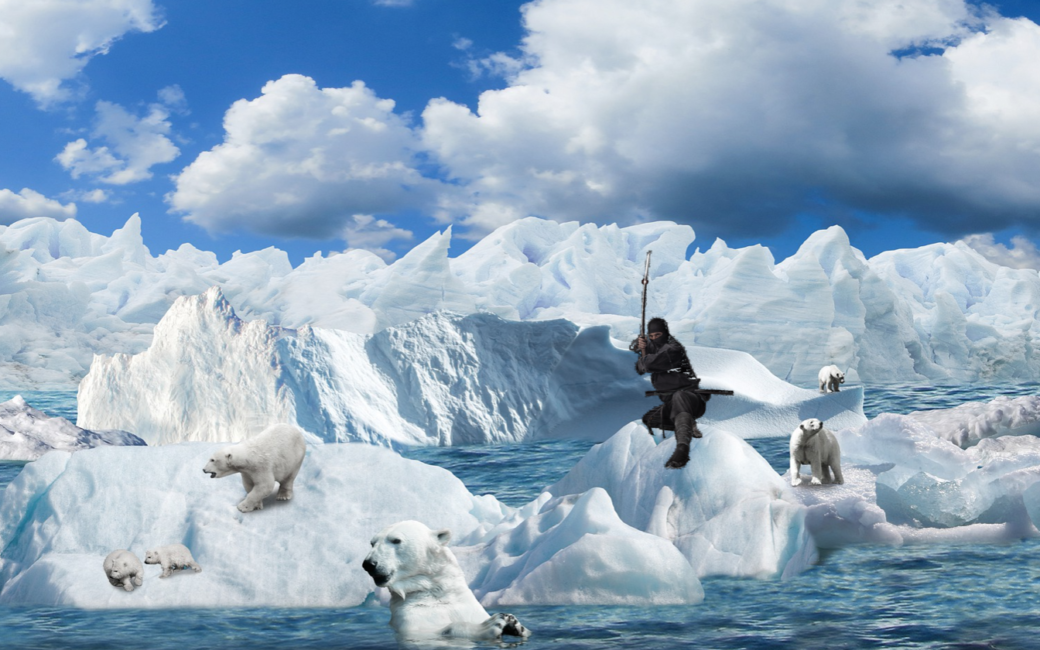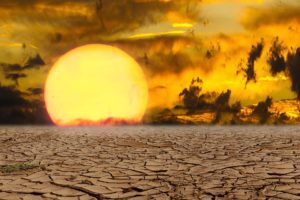 Brace yourself ninjas. I'm about to bum you out. But if you stick with me, there's rainbow unicorns at the end. I promise.
Brace yourself ninjas. I'm about to bum you out. But if you stick with me, there's rainbow unicorns at the end. I promise.
Chi, sui, ka, fu, and ku. These form the foundation for the San Shin or Gokui kata forms that Dai Shihan Mark Roemke teaches during his NTTV Live classes. These represent the elements of Earth, Water, Fire, Wind, and Void. We also use these elements as the thematic modules for our NiN or Ninjas in Nature training.
There is a another lens to view these elements as we humans collectively head into an uncertain planetary future with the growing disruptions of the climate.
Chi- the Earth, or the ground beneath our feet in many places, is drying due to drought, deforestation and desertification. It is also eroding at alarming rates due to industrial agriculture.
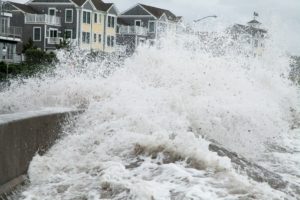 Sui- the waters are rising in the ocean as the glaciers melt, and the rains fall with unseasonable force and frequency.
Sui- the waters are rising in the ocean as the glaciers melt, and the rains fall with unseasonable force and frequency.
Ka- wildfires are becoming more frequent, intense, and devastating. I write this after a recent unseasonably late December wildfire tore through the Boulder, Colorado area.
Fu- the winds from hurricanes and tornadoes are occurring more frequently, with higher intensity, and longer seasonal duration.
But what of ku, the void? The mystery of the unknown is what lies before us all with our collective future on this planet.
But I don't mean to fill you with doom and gloom in describing this. I don't have to. There's plenty of others doing this for me. Sadly, the news is saturated daily with stories of the above elements gone haywire. It's hard for me to personally keep track of all the climate related disasters in this past year. But this is old news.
Doom and gloom. I know. But hang in there ninjas. I hear the hooves of unicorns approaching...
 I've been closely following the climate science for decades, since my work in the wildlife conservation field began over thirty years ago. I worked with critically endangered birds in Hawaii for many years. Hawaii was and unfortunately still is considered "the endangered species capital of the United States." We are in the midst of what is now considered the 6th great mass extinction event in the history of our planet. The last mass extinction event occurred at the end of the cretaceous period when a meteor took out the dinosaurs, and we all know how that turned out. For decades scientists have been raising red flags regarding the effects of climate change. While strides have been made in developing some green technologies, and some conservation efforts have succeeded, the unfortunate truth is that trends continue, and the intensity of the elements continues to amplify.
I've been closely following the climate science for decades, since my work in the wildlife conservation field began over thirty years ago. I worked with critically endangered birds in Hawaii for many years. Hawaii was and unfortunately still is considered "the endangered species capital of the United States." We are in the midst of what is now considered the 6th great mass extinction event in the history of our planet. The last mass extinction event occurred at the end of the cretaceous period when a meteor took out the dinosaurs, and we all know how that turned out. For decades scientists have been raising red flags regarding the effects of climate change. While strides have been made in developing some green technologies, and some conservation efforts have succeeded, the unfortunate truth is that trends continue, and the intensity of the elements continues to amplify.
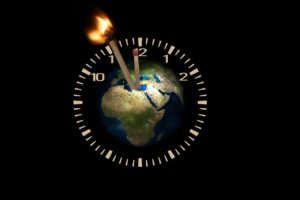 More recently, there is a new lexicon that has entered the climate change discussion from scientists, policy makers, and the public at large. These discussions include terms such as "tipping point," "the end of growth," "overreach," "collapsology," and even "the extinction of the human species." Many believe we have already passed the tipping point at which we can no longer hold back the devastation and disruption with increasing climate change. This discussion is supported by the fact that increasing average global temperature is no longer a linear progression with CO2 in the atmosphere. In other words, even if we could reverse, or remove the additional CO2 that began increasing with the industrial revolution, the climate would still continue to warm. This non-linear increase is due to things such as reduced solar reflection by snow in the polar regions, increased methane from melting permafrost in the arctic, subsurface oceanic methane release, and changes in the oceanic conveyor belt, to mention a few. There is a very real possibility that we have set things in motion that cannot be stopped at this point.
More recently, there is a new lexicon that has entered the climate change discussion from scientists, policy makers, and the public at large. These discussions include terms such as "tipping point," "the end of growth," "overreach," "collapsology," and even "the extinction of the human species." Many believe we have already passed the tipping point at which we can no longer hold back the devastation and disruption with increasing climate change. This discussion is supported by the fact that increasing average global temperature is no longer a linear progression with CO2 in the atmosphere. In other words, even if we could reverse, or remove the additional CO2 that began increasing with the industrial revolution, the climate would still continue to warm. This non-linear increase is due to things such as reduced solar reflection by snow in the polar regions, increased methane from melting permafrost in the arctic, subsurface oceanic methane release, and changes in the oceanic conveyor belt, to mention a few. There is a very real possibility that we have set things in motion that cannot be stopped at this point.
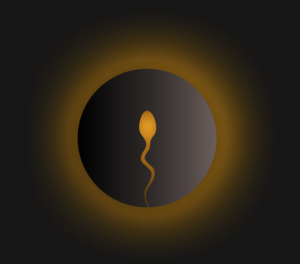 We are also on course for the end of growth, meaning when the growth of civilization collides with the end of finite resources, in other words the "collapse of civilization." This is predicted to occur around 2040. Interestingly, this is almost the exact time at which human fertility is predicted to reach zero, due to the presence of toxic chemicals to which we are all exposed. We will more or less cease to be able to reproduce as a species by this date. Recent studies are also showing that climate change is effecting the health of fetuses, babies and and infants globally while increased fossil fuel burning is lowering women's fertility. Not far behind this timeline is soil depletion by modern agricultural techniques. The UN estimates that all viable topsoil for farming will be depleted in 53 years if no changes are made in practices. Or looking at it another way, we have only 53 annual harvests remaining.
We are also on course for the end of growth, meaning when the growth of civilization collides with the end of finite resources, in other words the "collapse of civilization." This is predicted to occur around 2040. Interestingly, this is almost the exact time at which human fertility is predicted to reach zero, due to the presence of toxic chemicals to which we are all exposed. We will more or less cease to be able to reproduce as a species by this date. Recent studies are also showing that climate change is effecting the health of fetuses, babies and and infants globally while increased fossil fuel burning is lowering women's fertility. Not far behind this timeline is soil depletion by modern agricultural techniques. The UN estimates that all viable topsoil for farming will be depleted in 53 years if no changes are made in practices. Or looking at it another way, we have only 53 annual harvests remaining.
Have I totally bummed you out yet? Don't forget..rainbow unicorns.
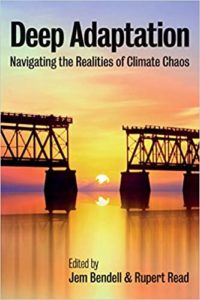 A 2018 article published by Jem Bendell entitled "Deep Adaptation: a map for navigating climate tragedy," quickly became a global phenomenon, with millions of downloads. It went viral. It sparked a new global movement and a subsequent book that was recently published. The idea behind deep adaptation states that while we need to continue to do everything we can to mitigate the effects of climate change, we need to prepare economically, culturally, socially, and psychologically for collapse. Further, while no one knows exactly what collapse will look like, we need to begin having these important discussions now, even as we are seeing increasing disruptions, so that we minimize the ultimate effects of the change that is coming during our lifetimes.
A 2018 article published by Jem Bendell entitled "Deep Adaptation: a map for navigating climate tragedy," quickly became a global phenomenon, with millions of downloads. It went viral. It sparked a new global movement and a subsequent book that was recently published. The idea behind deep adaptation states that while we need to continue to do everything we can to mitigate the effects of climate change, we need to prepare economically, culturally, socially, and psychologically for collapse. Further, while no one knows exactly what collapse will look like, we need to begin having these important discussions now, even as we are seeing increasing disruptions, so that we minimize the ultimate effects of the change that is coming during our lifetimes.
 How prepared are we currently for an economic and ecological societal collapse? More than 95% of the food coming into the major cities in our country arrives by long-distance trucking. If this ceased, it is estimated that New York would have a four day supply of food. Los Angeles would have three days of food. In 1880, 50% of Americans were farmers. Today, that number is less than 2%. In 1945, Americans grew 40% of their food in backyard gardens. That number is now less than 0.1%. This is homeland insecurity. I wonder how many Americans today can identify a single wild edible plant? How many know the ubiquitous edible "weeds" in their yards, that they kill with glyphosate herbicides at the cost to their own fertility and health? As I look out my kitchen window during the winter, I ask myself— how can I expand and grow more? What new wild edibles can I learn and find in the nearby forests?
How prepared are we currently for an economic and ecological societal collapse? More than 95% of the food coming into the major cities in our country arrives by long-distance trucking. If this ceased, it is estimated that New York would have a four day supply of food. Los Angeles would have three days of food. In 1880, 50% of Americans were farmers. Today, that number is less than 2%. In 1945, Americans grew 40% of their food in backyard gardens. That number is now less than 0.1%. This is homeland insecurity. I wonder how many Americans today can identify a single wild edible plant? How many know the ubiquitous edible "weeds" in their yards, that they kill with glyphosate herbicides at the cost to their own fertility and health? As I look out my kitchen window during the winter, I ask myself— how can I expand and grow more? What new wild edibles can I learn and find in the nearby forests?
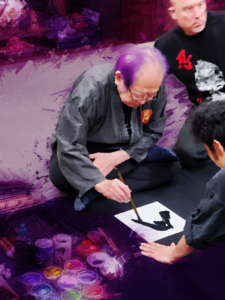 These realizations, however, have given me an awakened perspective on the value and role of the art of the ninja when faced with the possibility of collapse. If you examine historical examples of societal collapse, wars or social unrest typically precede or follow the downfall of civilizations. While actually having to defend yourself or others when faced with unrest might be a real matter worthy of discussion, there is a deeper value that I find in the art. The essence of perseverance, or the meaning of "nin," is at the heart of what motivates me daily when I wake. What am I going to do today, to take a necessary step towards adapting to the unknown that lies on the horizon? I have been teaching survival skills for years. Beyond shelter, water, fire, and food, we teach that attitude is the most important survival skill. If you give up, and admit defeat in the face of doom, then you most likely will fail. Remembering to embody the spirit of "nin" is thus essential to survival.
These realizations, however, have given me an awakened perspective on the value and role of the art of the ninja when faced with the possibility of collapse. If you examine historical examples of societal collapse, wars or social unrest typically precede or follow the downfall of civilizations. While actually having to defend yourself or others when faced with unrest might be a real matter worthy of discussion, there is a deeper value that I find in the art. The essence of perseverance, or the meaning of "nin," is at the heart of what motivates me daily when I wake. What am I going to do today, to take a necessary step towards adapting to the unknown that lies on the horizon? I have been teaching survival skills for years. Beyond shelter, water, fire, and food, we teach that attitude is the most important survival skill. If you give up, and admit defeat in the face of doom, then you most likely will fail. Remembering to embody the spirit of "nin" is thus essential to survival.
I have also realized that a valuable skill of the art of ninjutsu is being able to adapt to any situation. When training with Sensei Roemke, he is always throwing challenges at us that are outside the box, that cause us to think differently and adapt. I remember during one of my first classes, after I was feeling confident with all my forward, backwards, and sideways rolls, he suddenly threw a curve ball at us. He took every weapon off of the wall and scattered them all over the floor. Rokushaku bos, hanbos, bokken, kyoketsu shoges and more covered the majority of the mat. "Okay, everyone, zenpo kaiten naname, forward rolls, over the mat! Ready go!" I'll never forget that lesson. I had to adapt the basics to an unexpected, seemingly impossible challenge.
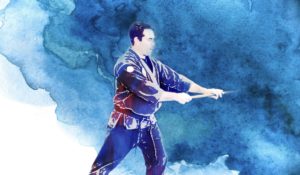 I posed this question to Dai Shihan Mark Roemke regarding this topic: How does the art of the ninja relate to an uncertain future of disruption on our planet? Here is his response.
I posed this question to Dai Shihan Mark Roemke regarding this topic: How does the art of the ninja relate to an uncertain future of disruption on our planet? Here is his response.
"The meaning of perseverance is to adapt or overcome. In our uncertain present and future, people need to learn to adapt. One way to persevere is to find a positive inner mindset. One of the key lessons that I have learned from Hatsumi Sensei, is to have a positive mental attitude. I have also learned this from my military and survival skills training. Your mind is so much stronger than your body. Your body will try to quit before your mind does. If you have fortitude, strong will, and perseverance, then you can adapt to any situation. Perseverance means to adapt in many ways— physically, mentally, and spiritually. This is a skill that modern ninjas have, that many people in our world lack. Most people will just give up in a challenging situation. The mindset of the ninja is to keep moving forward and thriving."
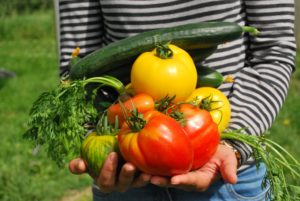 Beyond my garden, I think about my own kids and the youth I have encountered with the programs I teach. I realize that to simply hope that our governments and corporations can figure out a solution to climate change while continuing "business as usual" is not only foolish, but does an extreme disservice to the youth of today and the future generations. If I make it to 2045, I'll be firmly in my elder years. My kids, grandkids, or great grandkids (if there are still enough viable sperm and eggs by then) will be the ones facing the brunt of this trajectory. There's a song that I love that has the words that speak to this:
Beyond my garden, I think about my own kids and the youth I have encountered with the programs I teach. I realize that to simply hope that our governments and corporations can figure out a solution to climate change while continuing "business as usual" is not only foolish, but does an extreme disservice to the youth of today and the future generations. If I make it to 2045, I'll be firmly in my elder years. My kids, grandkids, or great grandkids (if there are still enough viable sperm and eggs by then) will be the ones facing the brunt of this trajectory. There's a song that I love that has the words that speak to this:
"The Earth is not given to us by our parents. It is loaned to us by our children's children." - Wookiefoot
These recent reports and projections were a real wake up call for me. I used to believe that even though I was trying to do what I could in this lifetime to make a positive change regarding the health of the planet, that the ultimate disruptions were far off on the horizon. There was still plenty of time. I no longer think that way, and I also realize that this ignorance is a form of denial.
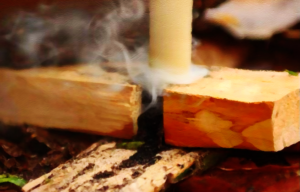 I also have a new perspective on the large volume of skills that we have put together for youth with our Ninjas in Nature program. I used to view them primarily as a means to help someone connect deeply to nature, while building powerful self sufficiency, awareness, and self confidence through the martial arts skills. Connect someone deeply to nature, and they will want to save it was once the standard mantra. The end result was a truly happy and whole being, with a desire to preserve nature, and still is. Unfortunately, the pragmatist and former Boys Scout in me remembers the old motto: "be prepared." How to prepare for an uncertain future, with no template from history to go by, is at the core of this challenge for me.
I also have a new perspective on the large volume of skills that we have put together for youth with our Ninjas in Nature program. I used to view them primarily as a means to help someone connect deeply to nature, while building powerful self sufficiency, awareness, and self confidence through the martial arts skills. Connect someone deeply to nature, and they will want to save it was once the standard mantra. The end result was a truly happy and whole being, with a desire to preserve nature, and still is. Unfortunately, the pragmatist and former Boys Scout in me remembers the old motto: "be prepared." How to prepare for an uncertain future, with no template from history to go by, is at the core of this challenge for me.
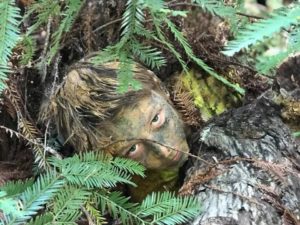 But now I see these skills as essential tools for adapting to the unknown change and disruptions to be faced by the inhabitants of our planet. It's not just the confidence of knowing how to find and process acorns as a vital protein source should the shipping trucks cease to show up, or how to make a fire by friction if the electricity goes down. It's about how to tap into the spirit of perseverance.
But now I see these skills as essential tools for adapting to the unknown change and disruptions to be faced by the inhabitants of our planet. It's not just the confidence of knowing how to find and process acorns as a vital protein source should the shipping trucks cease to show up, or how to make a fire by friction if the electricity goes down. It's about how to tap into the spirit of perseverance.
I've learned a lot by watching how youth in our nature program learn to adapt to challenges that nature throws unexpectedly at them. When they have been stung multiple times by an angry horde of wasps, and know how to find the nearby plantain remedy; when they have been covered head to toe in mud camouflage while crawling on their belly for hours in a forest at night; when they have found the glowing ember under their spindle with blistered, cold hands in a snowstorm when they needed a fire— in those moments I have witnessed something. I have seen that they knew discomfort and the unknown intimately. They knew failure. They knew perseverance. But above all, they knew the joy of what it meant to be truly alive and grateful for each day, and to be present in a moment in time. This mindset is the gift we can strive to pass on to our kids and future generations as we head into one of the greatest challenges our species has ever faced. Moreover, they are the skills that our ancestors depended upon and passed down to us. To me, passing down these important martial arts and survival skills are the essence of "nin" or being a ninja.
But I promised rainbow unicorns...
 Over 98% of all life that has ever lived on this planet has gone extinct. Think about that. The deck was stacked against us as a species long before we ever appeared on this planet. There have been five major extinction events in the history of planet Earth, and we likely are driving the current extinction bus blindly towards the precipice of the sixth. Still, after every major extinction event, something more beautiful evolved in the aftermath. Dinosaurs and ferns were pretty cool, but the mammals and flowering plants that followed were much more beautiful. I know. I'm a biased mammal. Still, I think the photographers and landscape artists are on my side. While this may sound like a nihilistic doomsday perspective, I find solace in stepping back to look at the wide angle vision, long view of our human time on Earth, and our collective connection to the mystery that holds this tapestry together. There is a beauty to this mystery that we are part of. One definition that I heard recently for "love" is a state of consciousness that is an awareness of beauty. I love the mystery.
Over 98% of all life that has ever lived on this planet has gone extinct. Think about that. The deck was stacked against us as a species long before we ever appeared on this planet. There have been five major extinction events in the history of planet Earth, and we likely are driving the current extinction bus blindly towards the precipice of the sixth. Still, after every major extinction event, something more beautiful evolved in the aftermath. Dinosaurs and ferns were pretty cool, but the mammals and flowering plants that followed were much more beautiful. I know. I'm a biased mammal. Still, I think the photographers and landscape artists are on my side. While this may sound like a nihilistic doomsday perspective, I find solace in stepping back to look at the wide angle vision, long view of our human time on Earth, and our collective connection to the mystery that holds this tapestry together. There is a beauty to this mystery that we are part of. One definition that I heard recently for "love" is a state of consciousness that is an awareness of beauty. I love the mystery.
Even with the long view odds stacked against us, and the short term prospects appearing a bit daunting for our survival, I'm an optimist. There's an opportunity here. Our old operating system of resource extraction for a distraction economy to produce giant piles of things in landfills that, in the end, have little meaning or value, has run its course. We have an opportunity to change the way we operate externally as humans who have been given the responsibility of stewarding this planet. But we also have an inner opportunity. We have an opportunity to evolve the way we think, act, and focus our internal and external energies as beings on this planet.
Chi, sui, ka, fu, ku. These energetic elements are within each of us. If we can bring these inner elements into alignment, our outer world, and all of its elements that are showing signs of dis-ease, just might find alignment. And if we don't pull this one off? Well...humans are beautiful. But you know, rainbow unicorns just might evolve after this sixth wave passes. And we all know...they're pretty awesome.
Check out the video below where Dai Shihan Mark Roemke demonstrates a technique to practice the elemental forms of Chi, Sui, Ka, Fu, and Ku from the San Shin or Gokui no Kata.
